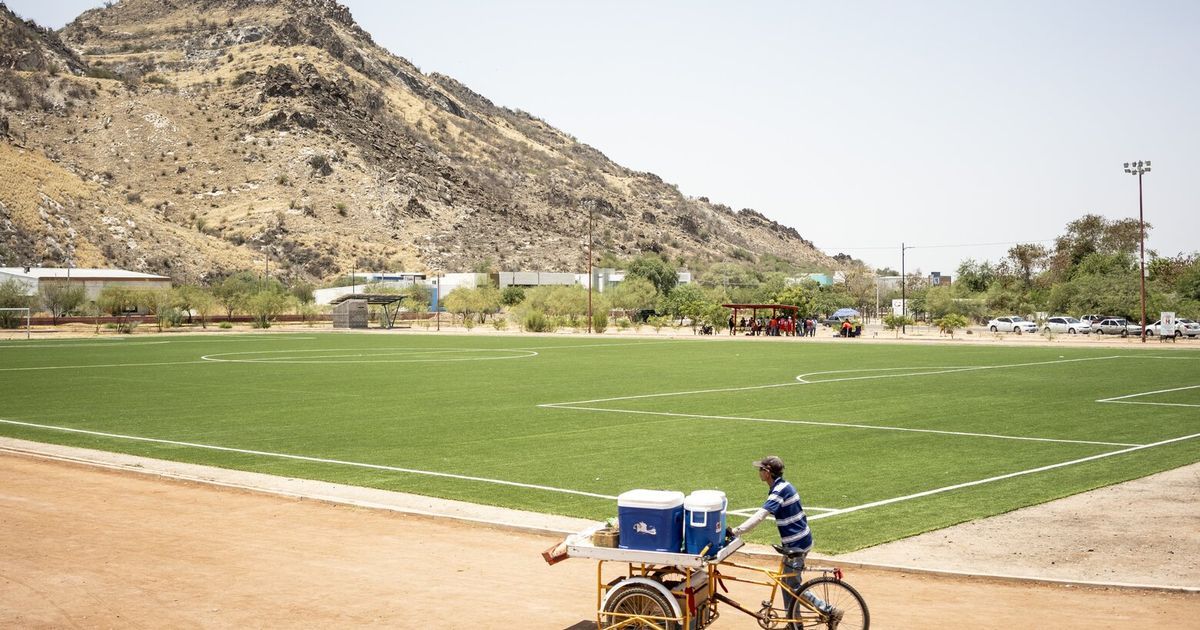What 120 degrees looks like in one of Mexico’s hottest cities
People in Hermosillo are used to the heat: Enduring scorching temperatures is a local point of pride in this northwestern Mexican city known for its blistering weather and nicknamed the “city of sun.”
But on a recent Sunday in June, temperatures reached a record high when thermometers registered 49.5 degrees Celsius, or 121 Fahrenheit.
“It was like I was being thrown balls of fire,” said Isabel Rodríguez, a gas station attendant on the road to Hermosillo. At a local fountain in the city, a father used his hat to pour water over his daughter as a reprieve from the heat.
Searing temperatures swept through the rest of the country, too.
June tends to be a rainy month in Mexico, but this year, El Nino, the global weather pattern often tied to intense heat, caused hotter, less rainy days. With temperatures above 104 degrees Fahrenheit, 23 Mexican states were under weather alerts last month. More than 110 people have died of heat-related causes this season.
In the northeastern part of the country, many schools ended classes early and others moved online to protect children from the intense heat. Cattle ranchers reported hundreds of deaths and millions of pesos in losses as their animals collapsed from heat exhaustion, unable to hydrate properly.
Advertising
“It’s very atypical, and it’s due to an anticyclone,” said Dr. Christian Domínguez Sarmiento, researcher at the Institute of Atmospheric Sciences and Climate Change at the National Autonomous University of Mexico.
This phenomenon, which creates air circulation in a clockwise direction, prevents the formation of clouds and, Domínguez Sarmiento added, “allows radiation to hit directly, as the sky is completely clear, and thus temperatures on the surface rise.”
The Madden-Julian Oscillation, a cluster of thunderstorms that travel the Equator regularly, was also at play, further preventing cloud formation, explained Domínguez Sarmiento.
The researcher added that land use also contributed to the heightened sensation of the heat: “If we had much more forest cover,” she said, referring to urban sprawl, “we might feel lower temperatures, but we are really surrounded by asphalt, and that also contributes to that discomfort feeling.”
In Hermosillo, a city of about 936,000 people, that feeling translated to burning eyes, throbbing heads and dripping sweat.
“Even with an umbrella,” said Luis Grande, a lone student walking on the campus of Sonora University, “I felt as if my eyes wanted to burst of the heat.”
Advertising
And yet, in Hermosillo, long used to scorching temperatures, life seemed to go on: Schools remained open, and women walked children to class; soccer games were still scheduled to be played at noon.
“It hit you, as if it were cooking your skin,” María Ángeles López, a housewife, said of the heat. She sat at Madero Park in downtown Hermosillo while her daughter, Aitana, played under a sprinkler.
“I felt desperate because of how unpleasant it felt,” she said, adding that her family owned three air conditioning units at home but that she tried to turn them off because electricity bills tended to increase during the hotter months.
Power outages have been reported throughout Mexico in recent weeks, a result of the high temperatures.
Half of all small grocery shops in the country had been affected by outages, and about 15% of those businesses lost refrigerated products, the National Alliance of Small Shopkeepers told local media.
In Mexico City, the capital, there was a shortage of ice, and some convenience stores rationed ice sales.
Advertising
Authorities in Hermosillo distributed water to homeless people and advised the population to wear hats and loose clothes, to cook less and avoid sun exposure. Some families sought solace in the waters of a nearby river, a one-hour drive from Hermosillo.
In Paseo El Molinito, a local recreation site outside the city, children splashed and parents sipped beer. A lazy hammock rocked to the faint rustle of leaves, while the music of an accordion radiated from a loudspeaker. A man in charge of collecting admission fees to the site planned on staying open past the usual time.
Smoke from a few small wildfires rose along the road leading from Hermosillo to El Molinito, making an unbearable day even more unpleasant. The Mexican state of Sonora, where Hermosillo is, has registered 89 wildfires so far in 2023, the highest number in more than two decades, according to the National Forestry Commission.
Mexico’s president, Andrés Manuel López Obrador, has criticized the media’s coverage of the heat wave, calling it overstated and sensationalist. He recommended that people “drink a lot of water, don’t get too exposed to the sun” and instructed citizens “to get up earlier,” like “rural farmers do.”
People in the rural areas of Sonora start working at 4 a.m. to avoid the sweltering heat and pause at noon. They break until 4 p.m., when weather conditions are again manageable.
And it’s not just humans who can’t tolerate the heat. Some electronic devices will shut down if they are exposed to high temperatures for too long.
“We still have July, August and September ahead,” said Refugio Estrada, who lives outside Hermosillo. People know the canícula, the dog days, are not yet here.
Source: The Seattle Times


